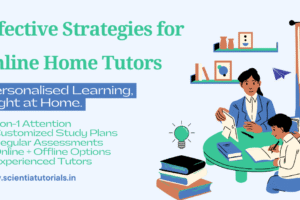Creating a Positive Learning Environment: Essential Teaching Tips for Home Tutors
Introduction
In today’s rapidly evolving educational landscape, home tutoring has emerged as a popular and effective alternative to traditional classroom learning. Home tutors play a vital role in shaping students’ academic experiences, providing personalized attention that is often lacking in larger school settings. However, the effectiveness of home tutoring significantly depends on the learning environment established during sessions. A positive learning environment fosters motivation, engagement, and a sense of security, which are crucial for effective learning. This article will explore essential tips for home tutors on how to create and maintain a positive learning environment, enabling students to thrive academically and personally.
Understanding the Importance of a Positive Learning Environment
Before diving into the strategies for fostering a positive learning atmosphere, it’s essential to understand why such an environment is crucial for students. A positive learning environment:
- Enhances Engagement: When students feel comfortable and safe, they are more likely to participate actively in discussions, ask questions, and engage with the material.
- Boosts Motivation: A supportive atmosphere encourages students to take ownership of their learning, setting and pursuing academic goals.
- Builds Confidence: Positive reinforcement and a non-judgmental space help students develop self-esteem, reducing anxiety and fear of failure.
- Facilitates Better Learning Outcomes: Research shows that students in nurturing environments tend to perform better academically and demonstrate improved retention of information.
With these benefits in mind, let’s explore actionable tips for home tutors to create a positive learning environment.
1. Establish Clear Communication
Open Dialogue
Creating a positive learning environment begins with establishing open lines of communication between the tutor, student, and, when applicable, parents. Encourage students to express their thoughts, feelings, and questions about their learning. This open dialogue can:
- Help tutors gauge students’ understanding and feelings about the material.
- Allow tutors to address concerns promptly.
- Foster a trusting relationship that promotes honesty and transparency.
Setting Expectations
At the beginning of the tutoring relationship, discuss the goals, expectations, and boundaries with the student. This discussion helps both parties understand what to expect, thereby reducing anxiety and confusion.
2. Create a Comfortable Physical Space
Design the Learning Environment
The physical environment plays a significant role in fostering a positive atmosphere. Here are some tips for creating a conducive learning space:
- Choose the Right Location: Select a quiet, well-lit space free from distractions like noise or excessive foot traffic.
- Organize the Space: Ensure that the area is tidy and organized. Having all necessary materials (books, stationery, technology) easily accessible minimizes disruptions.
- Make it Inviting: Personalize the learning area with motivational quotes, posters, or student work. An inviting space can inspire creativity and positivity.
Arrange Furniture Thoughtfully
Consider the layout of the furniture. Arrange tables and chairs to promote interaction and comfort. A round table setup can encourage discussion, while comfortable seating can make long sessions more enjoyable.
3. Incorporate Positive Reinforcement
Celebrate Achievements
Recognizing students’ efforts and accomplishments, no matter how small, is vital in fostering a positive learning environment. Use verbal praise, stickers, or a points system to celebrate achievements. Celebrating progress motivates students and reinforces their desire to learn.
Set Incremental Goals
Setting achievable short-term goals can provide students with a clear path to success. These milestones should be specific, measurable, and time-bound. When students reach these goals, celebrate their success to build their confidence and motivation.
4. Encourage Student Autonomy
Foster Independence
Empowering students to take control of their learning can significantly enhance their engagement. Involve them in the decision-making process by allowing them to choose topics of interest, methods of study, or types of assignments. This autonomy encourages ownership of their education and increases motivation.
Develop Self-Assessment Skills
Teach students how to assess their own understanding and progress. Encourage them to reflect on what they have learned, identify areas for improvement, and set personal learning goals. This self-awareness can enhance their learning experience and build resilience.
5. Be Adaptable and Flexible
Tailor Learning Approaches
Every student has a unique learning style. As a tutor, it’s essential to adapt your teaching methods to suit individual needs. Some students may respond well to visual aids, while others may prefer hands-on activities or auditory explanations. Flexibility in your approach demonstrates your commitment to their success.
Adjust to Feedback
Encourage students to provide feedback on what works best for them. Be open to adjusting your teaching strategies based on their responses. This adaptability fosters a collaborative atmosphere and shows students that their opinions matter.
6. Cultivate a Supportive Relationship
Build Rapport
Establishing a strong rapport with students is crucial for creating a positive learning environment. Take the time to get to know them personally—ask about their interests, hobbies, and goals. A genuine connection can help students feel valued and understood.
Be Approachable
Maintain a friendly and approachable demeanor. Encourage students to feel comfortable asking questions or expressing concerns without fear of judgment. A positive tutor-student relationship enhances trust and promotes open communication.
7. Utilize Interactive Learning Techniques
Incorporate Games and Activities
Engaging students through interactive learning techniques can make sessions more enjoyable and memorable. Use educational games, group activities, or creative projects to reinforce concepts and encourage collaboration. Interactive methods can transform mundane lessons into exciting experiences.
Integrate Technology
Incorporating technology can also enhance engagement. Use educational apps, online quizzes, and multimedia presentations to diversify learning methods. Technology can provide additional resources and tools that cater to different learning styles.
8. Encourage Social Interaction
Promote Group Activities
If possible, involve peers in tutoring sessions to promote social interaction. Group activities can enhance learning through collaboration, discussion, and sharing different perspectives. Working with peers helps students develop essential communication and teamwork skills.
Host Study Groups
Consider organizing study groups or peer tutoring sessions. These collaborative settings create a supportive community, allowing students to learn from one another while fostering a sense of belonging.
9. Focus on Emotional Well-Being
Recognize Stressors
Home tutoring can sometimes be stressful for students. Be attentive to signs of frustration, anxiety, or burnout. Acknowledge their feelings and provide support as needed. By addressing emotional well-being, you can create a more positive learning atmosphere.
Incorporate Mindfulness Techniques
Introduce mindfulness or relaxation techniques during sessions to help students manage stress. Simple breathing exercises, short breaks, or mindfulness activities can enhance focus and create a calm learning environment.
10. Continuously Reflect and Improve
Evaluate Your Practices
Regularly reflect on your tutoring sessions. Consider what worked well, what challenges arose, and how you can improve. Seeking feedback from students and parents can provide valuable insights into your teaching effectiveness.
Stay Open to Growth
Education is an evolving field. Stay informed about new teaching strategies, technologies, and developments in educational psychology. Embrace continuous learning to enhance your skills and adapt your methods to best support your students.
Conclusion
Creating a positive learning environment at home is essential for effective tutoring. By establishing clear communication, designing a comfortable space, incorporating positive reinforcement, and fostering student autonomy, home tutors can create an atmosphere conducive to learning. Additionally, by cultivating supportive relationships, utilizing interactive techniques, and focusing on emotional well-being, tutors can help students thrive academically and personally. Ultimately, a positive learning environment lays the foundation for lifelong learning, empowering students to reach their full potential. Embrace these strategies as you embark on your journey as a home tutor, and watch your students flourish in a nurturing and inspiring atmosphere.



